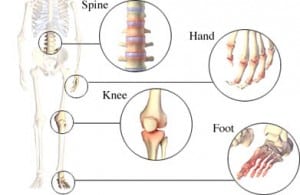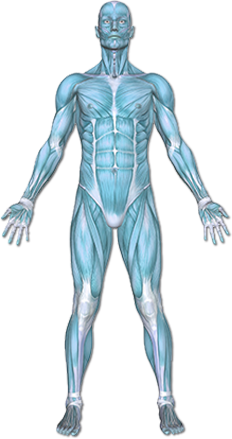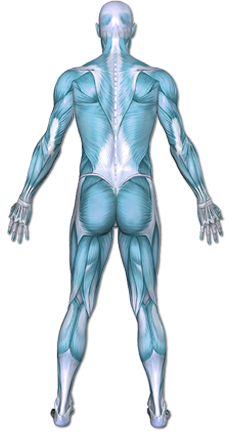Osteoarthritis
Osteoarthritis is the breakdown of cartilage in the joints. This is followed by chronic inflammation of the joint lining. Healthy cartilage is a cushion between the bones in a joint. Osteoarthritis usually affects the hands, feet, spine, hips, and knees. People with osteoarthritis usually have joint pain and limited movement of the affected joint.


Copyright © Nucleus Medical Media, Inc.
This content was created using EBSCO’s Health Library
The exact cause is unclear.
This content was created using EBSCO’s Health Library
Factors that may increase your chance of developing osteoarthritis include:
- Increasing age
- Excess body weight
- Family history of osteoarthritis
- Certain endocrine, metabolic, or neuropathic disorders, avascular necrosis
- Having an injury or surgery to the joint surface, especially the cartilage
- Having an occupation or doing physical activities that put stress on joints
This content was created using EBSCO’s Health Library
Osteoarthritis may cause:
- Mild-to-severe pain in a joint, especially after overuse or long periods of inactivity, such as sitting for a long time
- Creaking or grating sound in the joint
- Swelling, stiffness, limited movement of the joint, especially in the morning
- Deformity of the joint
This content was created using EBSCO’s Health Library
Your doctor will ask about your symptoms and medical history. A physical exam will be done. Tests may include:
- X-ray to see internal bony structures
- CT scan to look at the extent of the arthritis
- Arthrocentesis to rule out other causes of arthritis
- Blood tests to rule out other causes of arthritis
This content was created using EBSCO’s Health Library
The physical therapist’s role is to help decrease your pain and swelling, increase your strength and range of motion, and develop a suitable and effective home exercise program that will reduce the overall symptoms of osteoarthritis. The treatment plan in physical therapy might consist of:
- Strengthening, endurance, and flexibility exercises
- Manual therapy
- Electrical stimulation (ESTIM)
- Heat or cold packs
This content was created using EBSCO’s Health Library
To help reduce your chance of developing osteoarthritis, take these steps:
- Maintain a healthy weight.
- Do regular, gentle exercise, such as walking, stretching, swimming, or yoga.
- Avoid repetitive motions and risky activities that may contribute to joint injury, especially after age 40.
- With advancing age, certain activities may have to be stopped or modified. It is important to continue to be active, so find an activity that suits you.
This content was created using EBSCO’s Health Library
This content was created using EBSCO’s Health Library Resources
- American College of Rheumatology
- The Arthritis Foundation
CANADIAN RESOURCES:
- The Arthritis Society
- Seniors Canada
REFERENCES:
- American College of Rheumatology Subcommittee on Osteoarthritis. Recommendations for the medical management of osteoarthritis of the hip and knee. 2000 update. Arthritis Rheum. 2000;43:1905-1915.
- Jordan K, Arden N, et al. EULAR recommendations 2003: an evidence based approach to the management of knee osteoarthritis: report of a task force of the Standing Committee for International Clinical Studies Including Therapeutic Trials (ESCISIT). Ann Rheum Dis. 2003;62:1145-1155.
- Osteoarthritis. Arthritis Foundation website. Available at: http://www.arthrit… . Accessed September 3, 2013.
- Osteoarthritis. National Institute of Arthritis and Musculoskeletal and Skin Disorders website. Available at: http://www.niams.nih.gov/Health_Info/Osteoarthritis/default.asp . Updated July 2010. Accessed September 3, 2013.
- Sinusas, K. Osteoarthritis: Diagnosis and treatment. Am Fam Physician. 2012;85(1):49-56.
- van den Berg WB. Pathophysiology of osteoarthritis. Joint Bone Spine. 2000;67:555-556.
- 10/21/2008 DynaMed’s Systematic Literature Surveillance https://dynamed.ebscohost.com/about/about-us Fransen M, McConnell S. Exercise for osteoarthritis of the knee. Cochrane Database Syst Rev. 2008;CD004376.
- 12/11/2009 DynaMed’s Systematic Literature Surveillance https://dynamed.ebscohost.com/about/about-us: Rutjes WJ, Nuesch E, Sterchi R, et al. Transcutaneous electrostimulation for osteoarthritis of the knee. Cochrane Database Syst Rev. 2009;(4):CD002823.
- 10/15/2010 DynaMed’s Systematic Literature Surveillance https://dynamed.ebscohost.com/about/about-us: Wandel S, Jüni P, Tendal B, et al. Effects of glucosamine, chondroitin, or placebo in patients with osteoarthritis of hip or knee: network meta-analysis. BMJ. 2010;341:c4675.
- 10/26/2010 DynaMed’s Systematic Literature Surveillance https://dynamed.ebscohost.com/about/about-us: Massey T, Derry S, Moore R, McQuay H. Topical NSAIDs for acute pain in adults. Cochrane Database Syst Rev. 2010;(6):CD007402.
- 11/15/2010 DynaMed’s Systematic Literature Surveillance https://dynamed.ebscohost.com/about/about-us: US Food and Drug Administration. FDA clears Cymbalta to treat chronic musculoskeletal pain. US Food and Drug Administration website. Available at: http://www.fda.gov… . Updated April 19, 2013. Accessed July 23, 2013.
- 11/29/2010 DynaMed’s Systematic Literature Surveillance https://dynamed.ebscohost.com/about/about-us: French HP, Brennan A, White B, Cusack T. Manual therapy for osteoarthritis of the hip or knee: a systematic review. Man Ther. 2011;16(2):109-117.
- 7/15/2013 DynaMed’s Systematic Literature Surveillance https://dynamed.ebscohost.com/about/about-us: Dilek B, Gözüm M, Sahin E, et al. Efficacy of paraffin bath therapy in hand osteoarthritis: a single-blinded randomized controlled trial. Arch Phys Med Rehabil. 2013 Apr;94(4):642-9.
This content was created using EBSCO’s Health Library


